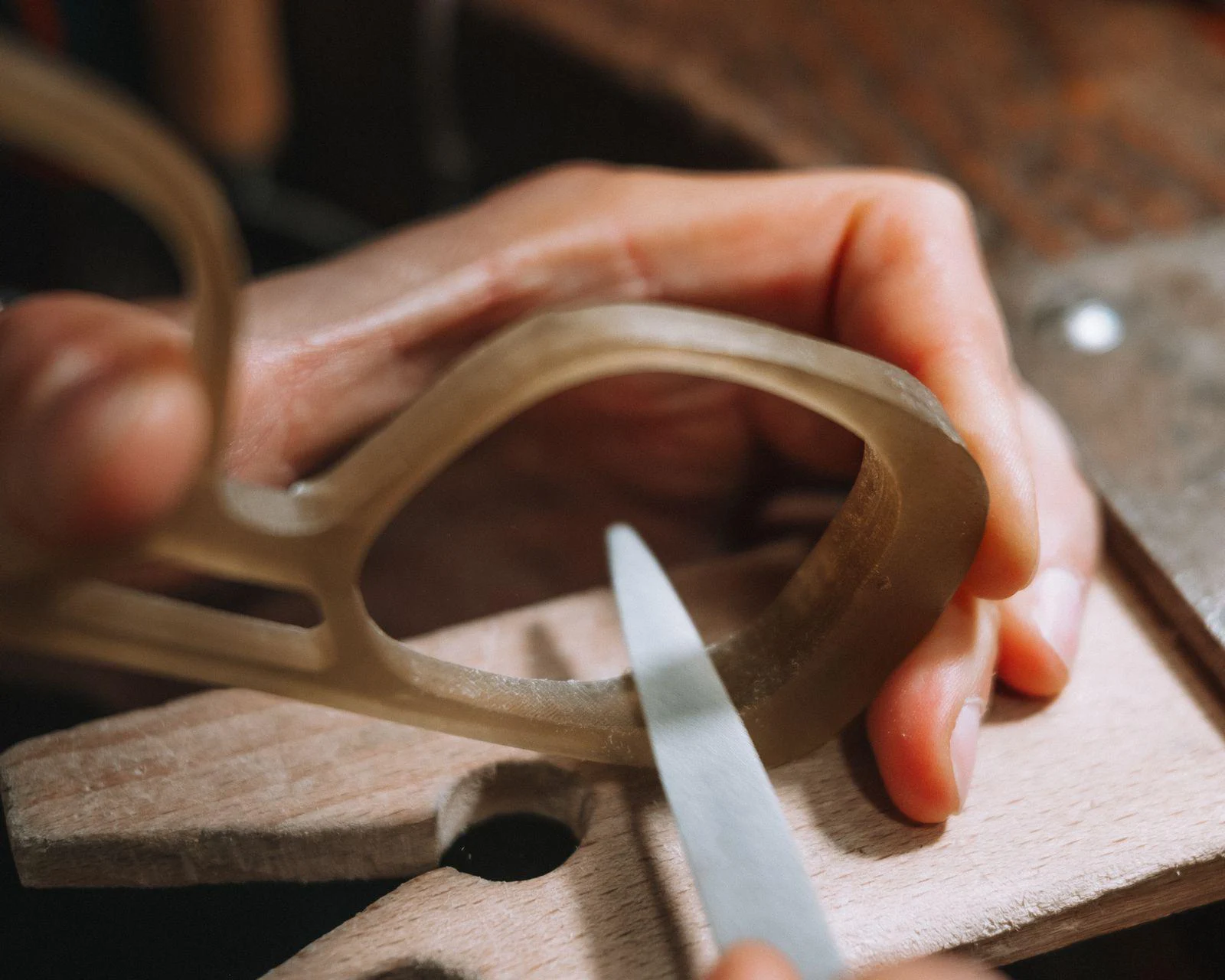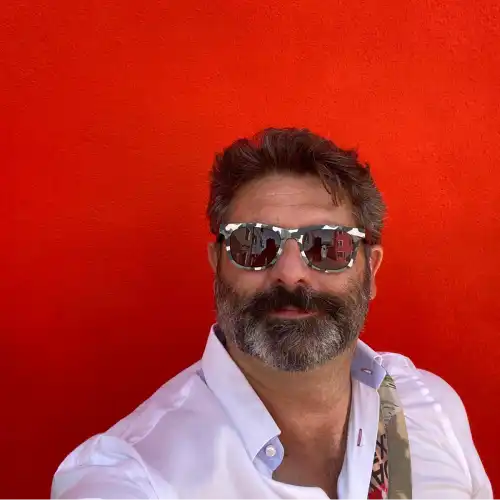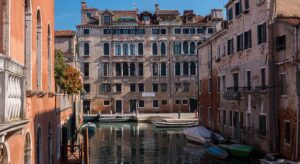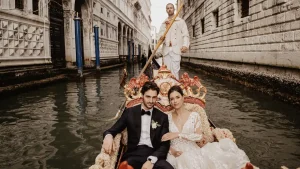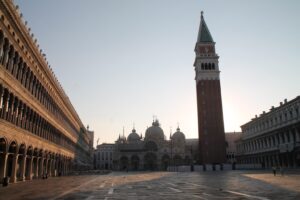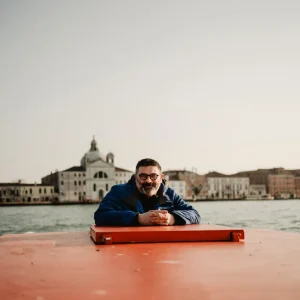Through Venetian Eyes: The Story Behind Our Bespoke Glasses Experience in Venice
When you think of Venice, you probably picture gondolas gliding through quiet canals, Renaissance palaces bathed in golden light, or perhaps a romantic sunset over the lagoon. But did you know that this same city — famous for its art, beauty, and invention — is also the birthplace of modern eyeglasses?
Yes, that’s right. Over 700 years ago, in a workshop not unlike the ones you still find tucked inside the labyrinth of Venice’s backstreets, the world’s first spectacles were born. And recently, we had the chance to step inside that legacy ourselves — to commission bespoke glasses made entirely by hand by one of the last remaining Venetian eyewear artisans.
This wasn’t just shopping. It was a journey through time, craftsmanship, and character. From the moment we stepped into a quiet, wood-scented workshop in Cannaregio to the instant we tried on our finished glasses, it felt like being part of something eternal — a living bridge between Venice’s past and its present creativity.
In this story, we’ll share that journey: the history of eyewear in Venice, the artistry behind every handmade frame, and the people who still keep this rare tradition alive. It’s a story of vision — in every sense of the word.
📜 A Legacy That Began in Venice
Let’s start with a little-known truth: Venice invented eyeglasses.
In the late 1200s, as Europe was emerging from the Middle Ages, Venetian monks and scholars were struggling with fading eyesight. Their world revolved around manuscripts, astronomy, and delicate craftsmanship — and when vision blurred, so did their livelihood. Enter Venice’s artisans: masters of glass, lenses, and light.
According to historical records, by around 1284, Venetian glassmakers — likely those working on Murano — began crafting primitive magnifying lenses. These were not yet the glasses we know today, but handheld tools that could magnify text and bring clarity back to aging eyes. Using finely ground quartz crystal, they transformed scientific curiosity into a life-changing invention.
At first, these “spectacles” were held by hand or balanced delicately on the nose. The familiar nose-bridge design we use today came centuries later. But the foundation of the idea — that glass could restore sight — was Venetian genius.
Why Venice? Because the lagoon’s artisans already possessed Europe’s most advanced glassmaking knowledge. Murano’s furnaces glowed with innovation — perfecting techniques for purity, transparency, and color. Combine that with trade routes connecting East and West, and Venice had both the materials and the minds to change human history.
It’s no coincidence that the same island that gave us chandeliers of impossible beauty also gave us the lens through which humanity began to see the world more clearly.
🏛️ The Art of the Frame: Visiting a Venetian Eyewear Artisan
Fast forward seven centuries. The city still hums with artistry — but few crafts are as rare, personal, and surprisingly poetic as bespoke eyewear.
After weeks of searching and a few whispered local recommendations (because in Venice, secrets travel by word of mouth), we found ourselves on a narrow lane just off Strada Nuova. A simple wooden sign marked the entrance to the atelier. Inside, sunlight spilled across oak workbenches covered with tools, lenses, and sketches — and the faint scent of wax and cedar hung in the air. It was like stepping into a Renaissance workshop preserved in time.
👓 Meeting the Maestro
The craftsman behind the counter, Tony, has been making glasses by hand for over 25 years. A true Venetian, he trained in Florence, Milan, and New York before returning home to revive a dying art. His workshop is part optical studio, part artist’s lab: shelves lined with vintage frames, drawers of colored acetates, old sketches curling at the edges, and tools that seem older than the city itself.
“Everyone’s face tells a story,” Tony said with a smile. “My job is to frame it in a way that respects it — and lasts for years.”
And with that, our own story began.
✏️ Step 1: The Design Consultation
As with everything in Venice, the process started with coffee — a tiny espresso served in a cup with a delicate Murano handle. Then came the questions. Not about fashion trends, but about life. How much time do we spend reading? Traveling? Working at screens? Do we prefer the brightness of sunlight or the calm of shadowed interiors?
He observed quietly, noting the curve of our faces, the tilt of our smiles, the fall of our hair. Then, in just a few pencil strokes, he sketched possibilities — frames that would enhance not just our sight, but our personality.
We chose two designs: one classic tortoiseshell pair for everyday use, and one pair of round sunglasses inspired by the iconic shapes worn by Venetian gondoliers in the 1930s. The lines were timeless, elegant, unmistakably Venetian.
🌿 Step 2: Materials & Craftsmanship
Each material Tony works with tells a story. Cellulose acetate — a plant-based alternative to plastic — offers color, strength, and eco-consciousness. Buffalo horn brings natural texture and depth. Wood adds warmth, while Murano glass inlays shimmer with the spirit of the lagoon.
For our frames, we chose polished acetate, both lightweight and durable. Tony explained that each sheet of acetate arrives flat — and must be hand-cut, heated, and curved into shape. No molds, no shortcuts. Every millimeter is guided by experience.
Nearby, his young apprentice — a quiet student from the Veneto mainland — demonstrated the heating process, using a small flame to soften the frame’s arms before bending them gently to fit. It’s precision work, done by touch and intuition rather than machines.
The hinges, imported from Germany, are selected for strength. The polishing process involves layers of natural wax. Even the case — lined with soft Venetian leather — is handmade locally. Nothing leaves the shop until it feels perfect in the hand.
In that moment, we realized this wasn’t just about seeing better. It was about seeing differently — slowing down to appreciate the artistry that hides in everyday objects.
🔍 Step 3: The Lenses & Fitting
While Tony crafts the frames, his lenses come from a specialized optical lab just outside Venice. He believes that clarity deserves craftsmanship too — the optical equivalent of Murano precision.
For our sunglasses, we chose polarized, UV-protected lenses tinted in a subtle lagoon green — a nod to the reflections that dance on the city’s waters. For the prescription pair, we opted for ultra-thin, anti-reflective lenses ideal for travel and digital work.
A week later, when we returned for the final fitting, Tony adjusted the arms by hand — heat, twist, check, repeat — until the glasses sat so naturally it was as if they’d always belonged to us. He smiled again, the quiet satisfaction of a master seeing his work come alive.
“Now,” he said, “you’ll see Venice the way it deserves to be seen.”
💡 Why Go Bespoke in Venice?
In an age of fast fashion and identical frames, getting glasses made in Venice feels revolutionary. It’s not just about luxury — it’s about connection. You’re investing in authentic craftsmanship, supporting local artisans, and wearing a piece of history that’s uniquely yours.
Venetian eyewear artisans like Tony are preserving a craft that could easily disappear within a generation. Their work represents everything we at Tour Leader Venice stand for: respect for tradition, beauty in detail, and a deep belief that travel should transform the way you see the world — literally.
Instead of buying a souvenir that gathers dust, imagine leaving Venice with something you’ll use every day — something that frames your memories as much as your eyes.
To experience this living heritage, you can book our Bespoke Eyewear Experience in Venice, where you’ll meet local artisans, learn their craft, and take home your own handmade masterpiece. It’s one of the most personal and meaningful experiences we offer — a way to literally see Venice through Venetian eyes.
🕶️ Sunglasses: Another Venetian Innovation
Here’s a fascinating footnote: even the concept of sunglasses has Venetian roots.
Centuries ago, Venetian sailors and gondoliers needed protection from the intense glare bouncing off the lagoon’s waters. Murano glassmakers began experimenting with smoked glass, infusing minerals like manganese to darken lenses and filter sunlight. These early “sun lenses” appeared in Venice long before sunglasses became fashionable in Paris or Hollywood.
So when you wear Venetian-made sunglasses today, you’re not just protecting your eyes — you’re continuing a 700-year-old story of innovation, beauty, and practicality.
For travelers seeking something special, our Bespoke Eyewear Experience offers the chance to design both prescription and sun lenses — merging history with style in the most Venetian way possible.
🎭 The Spirit of Venetian Craftsmanship
What struck us most about this experience wasn’t just the artistry, but the attitude. In Venice, craftsmanship is not nostalgia — it’s identity. Every artisan here, from mask-makers to glassblowers to opticians, treats their work as a dialogue with time. They’re not recreating the past; they’re keeping it alive by adapting it to today.
It’s the same philosophy behind other TLV favorites like our Venetian Mask Workshop, Marbled Paper Workshop, and Tessitura Bevilacqua Fabric Experience — each an invitation to touch, create, and understand Venice beyond the surface.
Our bespoke eyewear visit reminded us that even in a world of mass production, there’s still room for personal stories — for things made by hand, by heart, and by heritage.
🕰️ Final Thoughts: A Truly Venetian Experience
Of all the experiences we’ve had in Venice — exploring hidden courtyards, gliding through canals at sunset, tasting cicchetti and wine — this one felt the most intimate. It wasn’t about sightseeing. It was about seeing.
When we first slipped on our new glasses, it wasn’t just our vision that sharpened — it was our awareness of what Venice truly stands for: patience, artistry, and a quiet defiance against time.
These aren’t accessories. They’re heirlooms in the making — living proof that craftsmanship, when protected and celebrated, still has the power to move us.
So the next time you’re in Venice, step away from the crowds and into one of these workshops. Talk to the makers. Listen to their stories. And perhaps walk away with more than just a souvenir — walk away with a piece of Venice that will travel with you every day.
📅 Planning Your Visit: How to Book Your Bespoke Glasses Experience
- 🕰️ Timing: Allow about one week for design, production, and fitting. For fully customized orders, 5–7 weeks is ideal.
- 📞 Appointments: Artisans work by appointment only. We’ll help you schedule your private session with the master craftsman.
- 🌿 Materials: Ask about eco-friendly options like acetate, horn, or Murano inlays.
- 💡 Limited Time? Some ateliers also offer ready-made limited editions if you’re short on time.
If you’d like to experience this yourself, contact us here. We’ll handle all the arrangements — from introductions to translation — so all you need to do is show up and enjoy one of the most personal and exclusive experiences in Venice.
✨ Book Your Bespoke Eyewear Experience in Venice
See Venice differently — through craftsmanship, creativity, and the clarity of a true Venetian vision.
FAQs About the Bespoke Eyewear Experience in Venice
How long does the Bespoke Eyewear Experience take?
Plan for about one hour for your private design consultation and fitting with the artisan, followed by several months for production. Each frame is handmade from start to finish — a process of precision, patience, and artistry. .
Can I really design my own glasses or sunglasses?
Absolutely. Every pair is fully customized — from the frame shape and material to lens color and finish. Choose from eco-friendly acetate, horn, . You’ll work side-by-side with the artisan to create eyewear that fits your face, lifestyle, and personality perfectly.
Is this experience suitable for visitors who don’t need prescription lenses?
Yes! Many guests choose to design sunglasses or fashion frames purely for style and craftsmanship. The experience focuses on artistry as much as optics — just like our Create Your Own Masterpiece — Venetian Mask Workshop and Traditional Marbled Paper Workshop in Venice. It’s a celebration of Venetian creativity you can wear every day.

